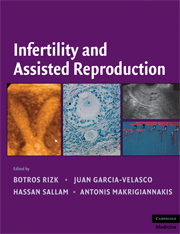Book contents
- Frontmatter
- Contents
- Contributors
- Foreword
- Preface
- Introduction
- PART I PHYSIOLOGY OF REPRODUCTION
- PART II INFERTILITY EVALUATION AND TREATMENT
- PART III ASSISTED REPRODUCTION
- 38 Medical Strategies to Improve ART Outcome: Current Evidence
- 39 Surgical Preparation of the Patient for In Vitro Fertilization
- 40 IVF in the Medically Complicated Patient
- 41 Polycystic Ovary Syndrome and IVF
- 42 Endometriosis and Assisted Reproductive Technology
- 43 Evidence-Based Medicine Comparing hMG/FSH and Agonist/Antagonist and rec/Urinary hCG/LH/GnRH to Trigger Ovulation
- 44 Luteal Phase Support in Assisted Reproduction
- 45 Thrombophilia and Implanation Failure
- 46 Intrauterine Insemination
- 47 The Prediction and Management of Poor Responders in ART
- 48 Oocyte Donation
- 49 In Vitro Maturation of Human Oocytes
- 50 Oocyte and Embryo Freezing
- 51 Cryopreservation of Male Gametes
- 52 The Management of Azoospermia
- 53 Spermatid Injection: Current Status
- 54 Optimizing Embryo Transfer
- 55 Single Embryo Transfer
- 56 Blastocyst Transfer
- 57 Clinical Significance of Embryo Multinucleation
- 58 Quality and Risk Management in the IVF Laboratory
- 59 The Nurse and REI
- 60 Understanding Factors That Influence the Assessment of Outcomes in Assisted Reproductive Technologies
- 61 The Revolution of Assisted Reproductive Technologies: How Traditional Chinese Medicine Impacted Reproductive Outcomes in the Treatment of Infertile Couples
- 62 Complications of Assisted Reproductive Technology
- 63 Ectopic and Heterotopic Pregnancies Following in Vitro Fertilization
- 64 The Impact of Oxidative Stress on Female Reproduction and ART: An Evidence-Based Review
- 65 PGD for Chromosomal Anomalies
- 66 Preimplantation Genetic Diagnosis for Single-Gene Disorders
- 67 Epigenetics and ART
- 68 Congenital Anomalies and Assisted Reproductive Technology
- PART IV ETHICAL DILEMMAS IN FERTILITY AND ASSISTED REPRODUCTION
- Index
- Plate section
- References
41 - Polycystic Ovary Syndrome and IVF
from PART III - ASSISTED REPRODUCTION
Published online by Cambridge University Press: 04 August 2010
- Frontmatter
- Contents
- Contributors
- Foreword
- Preface
- Introduction
- PART I PHYSIOLOGY OF REPRODUCTION
- PART II INFERTILITY EVALUATION AND TREATMENT
- PART III ASSISTED REPRODUCTION
- 38 Medical Strategies to Improve ART Outcome: Current Evidence
- 39 Surgical Preparation of the Patient for In Vitro Fertilization
- 40 IVF in the Medically Complicated Patient
- 41 Polycystic Ovary Syndrome and IVF
- 42 Endometriosis and Assisted Reproductive Technology
- 43 Evidence-Based Medicine Comparing hMG/FSH and Agonist/Antagonist and rec/Urinary hCG/LH/GnRH to Trigger Ovulation
- 44 Luteal Phase Support in Assisted Reproduction
- 45 Thrombophilia and Implanation Failure
- 46 Intrauterine Insemination
- 47 The Prediction and Management of Poor Responders in ART
- 48 Oocyte Donation
- 49 In Vitro Maturation of Human Oocytes
- 50 Oocyte and Embryo Freezing
- 51 Cryopreservation of Male Gametes
- 52 The Management of Azoospermia
- 53 Spermatid Injection: Current Status
- 54 Optimizing Embryo Transfer
- 55 Single Embryo Transfer
- 56 Blastocyst Transfer
- 57 Clinical Significance of Embryo Multinucleation
- 58 Quality and Risk Management in the IVF Laboratory
- 59 The Nurse and REI
- 60 Understanding Factors That Influence the Assessment of Outcomes in Assisted Reproductive Technologies
- 61 The Revolution of Assisted Reproductive Technologies: How Traditional Chinese Medicine Impacted Reproductive Outcomes in the Treatment of Infertile Couples
- 62 Complications of Assisted Reproductive Technology
- 63 Ectopic and Heterotopic Pregnancies Following in Vitro Fertilization
- 64 The Impact of Oxidative Stress on Female Reproduction and ART: An Evidence-Based Review
- 65 PGD for Chromosomal Anomalies
- 66 Preimplantation Genetic Diagnosis for Single-Gene Disorders
- 67 Epigenetics and ART
- 68 Congenital Anomalies and Assisted Reproductive Technology
- PART IV ETHICAL DILEMMAS IN FERTILITY AND ASSISTED REPRODUCTION
- Index
- Plate section
- References
Summary
INTRODUCTION
Polycystic ovary syndrome (PCOS), characterized by ovulatory dysfunction and hyperandrogenism, is the most common cause of infertility in women. Although prevalence data are limited, PCOS is thought to be one of the most common endocrinopathies in women (1). The prevalence of PCOS in women of reproductive age is changed in between 4.7 and 6.8 percent (2–4).
The classic syndrome originally was described by Stein and Leventhal as the association of amenorrhea with polycystic ovaries and, variably, hirsutism and obesity (5). It is now recognized that PCOS represents a spectrum of disease characterized primarily by the following features: hyperandrogenism, menstrual irregularity, polycystic ovaries (PCO), and central adiposity.
Two diagnostic criteria have been developed to identify and diagnose all patients with PCOS (6). In 1990, the National Institutes of Health Conference on PCOS defined PCOS as chronic, unexplained hyperandrogenism and menstrual dysfunction. Hyperandrogenism could be defined by either clinical or biochemical findings. In 2003, the European Society of Human Reproduction and Embryology/American Society of Reproductive Medicine consensus workshop group added polycystic ovaries as an alternative finding (7). The Rotterdam criteria define PCOS when two of the three primary features are present: PCO, oligoanovulation, and/or clinical or biochemical signs of unexplained hyperandrogenism.
The woman with PCOS usually presents to the gynecologist with menstrual dysfunction and complaints secondary to hyperandrogenism or unsuccessful reproduction. The reproductive problems relate both to subfertility, secondary to anovulation, and to early pregnancy loss.
Keywords
- Type
- Chapter
- Information
- Infertility and Assisted Reproduction , pp. 375 - 380Publisher: Cambridge University PressPrint publication year: 2008



